
The Evolution of Jose Mourinho
As the cliche goes - “People need to adapt themselves to changing times and situations.” As time moves, so do people. Old institutions and ideas are swept away by a wave of fresh principles and ideologies. The same thing applies to the world of football – the evolution of the game down the years – the changing roles of players, managers evolving their tactical systems, provide ample testimony to the saying.
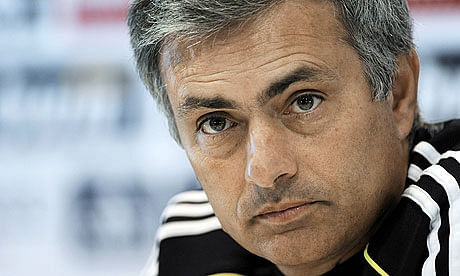
Jose Mourinho – the self-proclaimed ‘special-one’ has already achieved special things in his relatively short managerial career. Winning the Champions League with two different clubs, clinching innumerable league titles and a plenitude of League Cups – acting as the icing on the cake.
But there is something else, apart from the success that the Portuguese Mastermind is renowned for, his tactical setups of his teams is spell binding. From winning the Champions League by building a wall of steel at the San Siro, Jose Mourinho has set Madrid well on their way to the double (The League and the European Cup) by opponents in waves of an exhilarating display of attack. The focus of this particular piece lies on, how Mourinho has evolved from being defense to an attack minded manager? Let us have a detailed tactical look.
FC PORTO
It would be fair to say that FC Porto under Mourinho – were nearly an unbeatable force. After winning the UEFA Cup in the 2002-03 season, Porto went on to clinch the much coveted Champions League in the 2003-04 season. Besides being close to untouchable in their own country, Porto had established themselves as an European powerhouse. But, how did the ‘Special One’ turn Porto from a ‘fairly good club – who could spring the odd surprise, to a powerhouse? Let us have a look.
- FC Porto – The Starting XI.
(The arrows suggest player movement)
Formation – 4-3-1-2 (Diamond) In order to understand better about Mourinho’s Porto, one needs to first understand how a diamond actually works? The Diamond formation basically refers to the diamond formation in midfield (as can be seen in the board above). The holding midfielder and attacking midfielder are flanked by two wingers, who drift into midfield in order to close down the spaces, thereby leaving huge amounts of space on the flanks for both the fullbacks – who ultimately provide the width while attacking. In the Porto squad of 03-04, Costinha played the holding midfielder, and Deco was the attacking midfielder.
The ‘narrow width’ was provided by Maniche, a wide midfielder and Pedro Mendes, a Central Midfielder. This system gave Deco the additional freedom to operate freely as the ‘trequartista’ and provide plenty of ammunition to the two strikers – Carlos Alberto and Derlei.
The obvious flaw of the diamond system is the lack of width – which could be readily exploited by any team which has decent width . How did Mourinho counter this? Maniche and Mendes were given the responsibility of moving wide and marking the opposition full-backs – thus cutting down on any spaces which could be exploited.
CHELSEA
Chelsea, under Jose Mourinho, were among the most feared sides of the land and the Russian billionaire, Roman Abrahamovic played a big part in building Chelsea by bringing the top talents around the world to display their flamboyance in West London, and who better than Jose Mourinho to make efficient utilization of the ocean of talent at his disposal!
A keener look at the team shall explain Mourinho’s setup better.
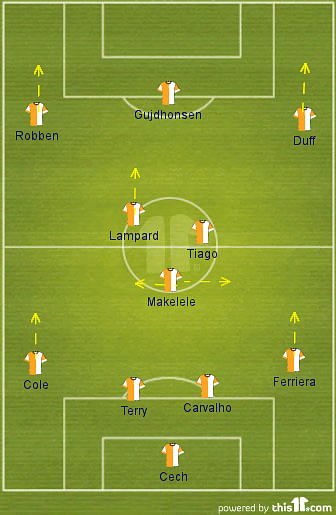
Chelsea's starting XI
(Arrows indicate player movement)
Formation : 4-3-3
A conventional 4-3-3 that had a premier destroyer in Makelele, Tiago keeping things simple in the middle, and the undoubted genius of Frank Lampard along with the brilliance of Robben’s left foot and the craft and vision of the Irish wonder Damien Duff, providing the spice to the Blue delicacy.
Along with an indomitable midfield, Mourinho had constructed a wall of four in front of Peter Cech. A wall that hardly lets anyone bulldoze past it. Ricardo Carvalho and John Terry formed an unshaken core of the defense which was ably flanked by Ferreira and Gallas. The wall leaked in a paltry 15 goals in the league in his first season.
The flanks were ably guarded by Cole and Ferreira, who in addition to defending, provided ample in attack, as seen from the formation diagram. Robben and Duff worked as a conventional winger pair, going past full backs with ease and leaving the defenders dead for want of pace. Ashley Cole and Paulo Ferreira were known for their overlaps, and when it happened, Duff and Robben would provide cover with the help of Makelele, thereby minimizing the threat from opposition counters. Lampard as always provided the craft from midfield and also popped up in the box to score vital goals. In fact, he had a season ending tally of 19 goals.
The apparent lack of depth in striking options was then resolved by the arrival of the African Beast – Didier Drogba, from Marseille.
Perhaps, one could always point a finger towards the ‘defensive’ game-play of Mourinho’s Chelsea. In the record-breaking season of 2004-05, in which Chelsea amassed a massive 95 points to clinch the Barclays Premier League, they scored a meagre 72 goals with all the flamboyance in attack. Whilst second placed Arsenal scored 87 goals.
INTER MILAN
Mourinho left Chelsea in rather controversial circumstances – to fill the hot seat of the blue half of San Siro, and though the first season brought a domestic glory for Inter, they have never made it big on the European stage. But it was the 2009-10 season which changed the scenario completely, as Jose led the Nerazzuri to an unprecedented treble.
Certain points – that need to be kept in mind while tactically dissecting this Inter side, are :
1) The Inter side was primarily a defensive side, built on the pillars of the proverb – ‘Defence is the best form of attack’ and not the other way around.
2) The team was set primarily to knick matches on the counter. Infact, as the tabloids pointed out – ‘Jose Mourinho won the Champions League with Inter on the counter!’
Let us now divulge into the matter on hand :
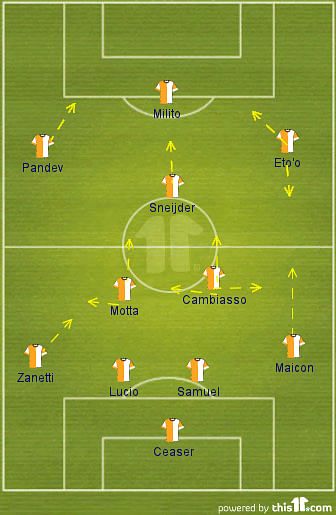
- Inter Starting XI.
(Arrows indicate player movement)
Formation : 4-2-1-3
The Inter of 2009-10 was probably one of the most well drilled and disciplined defensive units of the modern era . Not many would have a setup in which two conventional center forwards are deployed as wing forwards, and to add an extra layer of surprise, they were also handed the responsibility of tracking back into midfield while defending!
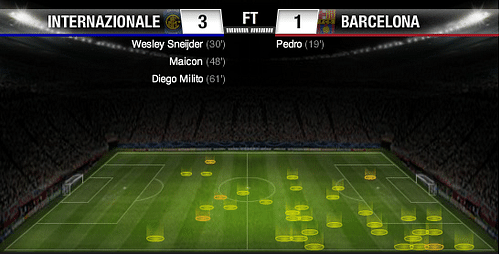
- Heatmap depicting Samuel Eto’o ‘s positioning.
Notice the concentration of yellow dots along the right wing, the center circle and the attacking midfield positions. It clearly depicts the defensive positions taken up by Eto’o.
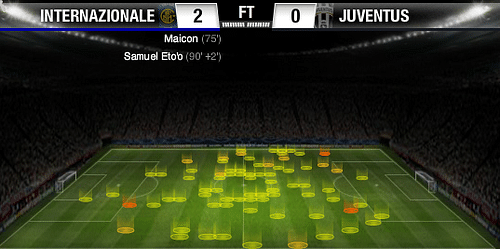
- Cambiasso’s heat map.
The Cambiasso – Motta partnership was a very sound combo in the middle of the park. When on the front foot, either of Cambiasso/Motta would make the forward run, and the other would cover for the forward running midfielder, with help from Zanetti(on occasions). In this heatmap, we see the yellow dots all over the pitch – showing Cambiasso’s forward and sideways movements.
Let us now have a look at Zanetti’s heatmap to clarify things :
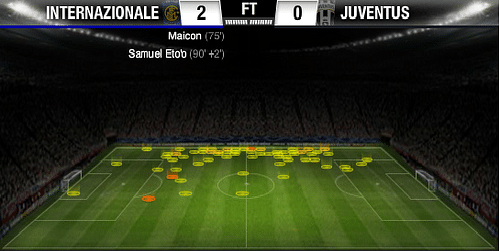
- Zanetti’s heatmap. – The yellow dots in the center denote the positioning of Zanetti when he tucks into midfield, to provide cover – alongside the other holding midfielder.
And then, came the call from Florentino Perez. An offer to manage Real Madrid, is almost impossible to reject for any manager, and as the age old saying goes - ‘No one says NO to Florentino Perez’.
But, this call was no ordinary call. Managing the most glamorous club of the world is not an easy job – the fans, media and the critics are always ready to pounce on the slightest of mistakes and tear apart the reputation into pieces.
Mourinho had established his image as a defensive coach – rarely did his teams go for the kill.
Mourinho was appointed with one primary objective – to usurp Barcelona from their throne. And along with this, there was the task of making his team play football which was soothing to the eyes of nearly 90,000 Madridstas who flocked to the Bernebeau every game, and the millions of fans who watched them on TV.
And, the rest as they say is history. Real have been scoring goals galore under Mourinho – who has surprisingly shifted his focus from defense to attack.
Below is a comprehensive analysis of how Mourinho has managed to build a side which scores goals for fun, and remains pretty tight at the back too.
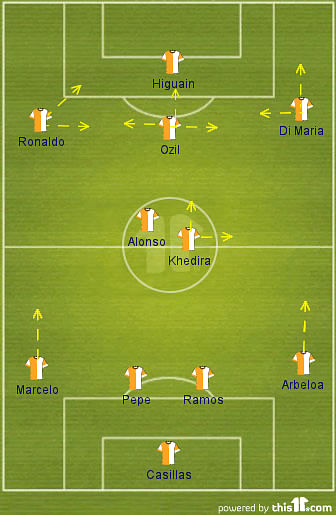
- Real Madrid’s starting XI.
(Arrows indicate player movement)
Formation : 4-2-3-1
Firstly, the set-up of this team is quite different from the previous teams of the Special One. In this team, the double pivot DOES NOT consist of two conventional Defensive Midfielders (like it was the case at Inter). The presence of a world-class playmaker in Xabi Alonso gives Mourinho the creativity from deep. Thus, it directly makes Real’s attack all the more fluid.
Besides the Cristiano Ronaldo factor on the left wing, Los Merengues have arguably one the best attacking midfielders at the moment – Mesut Ozil, and Angel Di Maria on the right. These two constantly interchange positions, making the attack all the more fluid and leaving the opposition’s defense in doldrums.
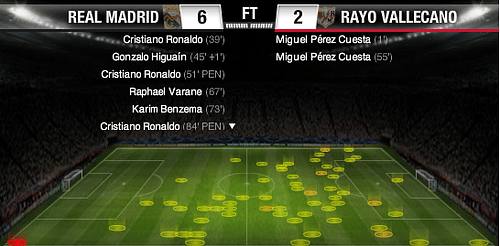
- Angel Di Maria’s heatmap – Notice the positions taken up.
Putting Khedira under the microscope, let us analyze his movements to cover the midfield :
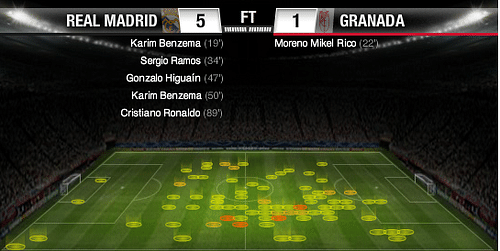
- Sami Khedira’s heatmap – Tireless running, all around the pitch.
Notice the concentration yellow dots in central midfield, these are positions taken up by the German when Madrid defend. The concentration of yellow and orange zones in the advanced midfield positions depict the positioning of Khedira when Madrid attack.
A good coach is one who always plays to the strengths of his squad. The best coaches down the years have done the same, and not many would argue against the fact that Mourinho has always prepared his sides in such a way that it makes each player comfortable with the role he has been assigned with. Down the years, Mourinho’s evolution from a defensive coach to a flamboyant attacking manager shows just that.